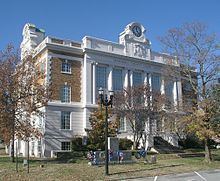Area 973.8 km² Population 31,130 (2013) | Congressional district 4th Website marshallcountytn.com Founded 20 February 1836 | |
 | ||
Rivers Duck River, Richland Creek, Flat Creek, Bear Creek | ||
Marshall County is a county located in the U.S. state of Tennessee. As of the 2010 census, the population was 30,617. Its county seat is Lewisburg.
Contents
- Map of Marshall County TN USA
- History
- Geography
- Adjacent counties
- State protected areas
- Demographics
- City
- Towns
- Unincorporated communities
- References
Map of Marshall County, TN, USA
Marshall County comprises the Lewisburg, TN Micropolitan Statistical Area, which is also included in the Nashville-Davidson-Murfreseboro, TN Combined Statistical Area.
Marshall County is the home of the Tennessee Walking Horse Breeders' and Exhibitors' Association. Another native of Marshall County is the fainting goat. To celebrate this unique breed, the county holds an annual festival known as "Goats, Music and More," drawing visitors from around the world.
History
Marshall County was created in 1836 from parts of Giles, Bedford, Lincoln and Maury counties, and was named after the American jurist, John Marshall, Chief Justice of the U.S. Supreme Court.
Three Tennessee governors— Buford Ellington, Henry Hollis Horton, and Jim Nance McCord— lived in Marshall County at the time of their run for governor.
Geography
According to the U.S. Census Bureau, the county has a total area of 376 square miles (970 km2), of which 375 square miles (970 km2) is land and 0.7 square miles (1.8 km2) (0.2%) is water. The Duck River drains much of the county.
Adjacent counties
State protected areas
Demographics
As of the census of 2000, there were 26,767 people, 10,307 households, and 7,472 families residing in the county. The population density was 71 people per square mile (28/km²). There were 11,181 housing units at an average density of 30 per square mile (12/km²). The racial makeup of the county was 89.42% White, 7.77% Black or African American, 0.25% Native American, 0.31% Asian, 0.01% Pacific Islander, 1.46% from other races, and 0.77% from two or more races. 2.87% of the population were Hispanic or Latino of any race.
There were 10,307 households out of which 33.80% had children under the age of 18 living with them, 56.80% were married couples living together, 11.60% had a female householder with no husband present, and 27.50% were non-families. 23.90% of all households were made up of individuals and 10.00% had someone living alone who was 65 years of age or older. The average household size was 2.56 and the average family size was 3.02.
In the county, the population was spread out with 25.60% under the age of 18, 8.70% from 18 to 24, 29.90% from 25 to 44, 23.20% from 45 to 64, and 12.60% who were 65 years of age or older. The median age was 36 years. For every 100 females there were 95.40 males. For every 100 females age 18 and over, there were 92.90 males.
The median income for a household in the county was $38,457, and the median income for a family was $45,731. Males had a median income of $31,876 versus $22,362 for females. The per capita income for the county was $17,749. About 7.30% of families and 10.00% of the population were below the poverty line, including 10.80% of those under age 18 and 13.10% of those age 65 or over.
